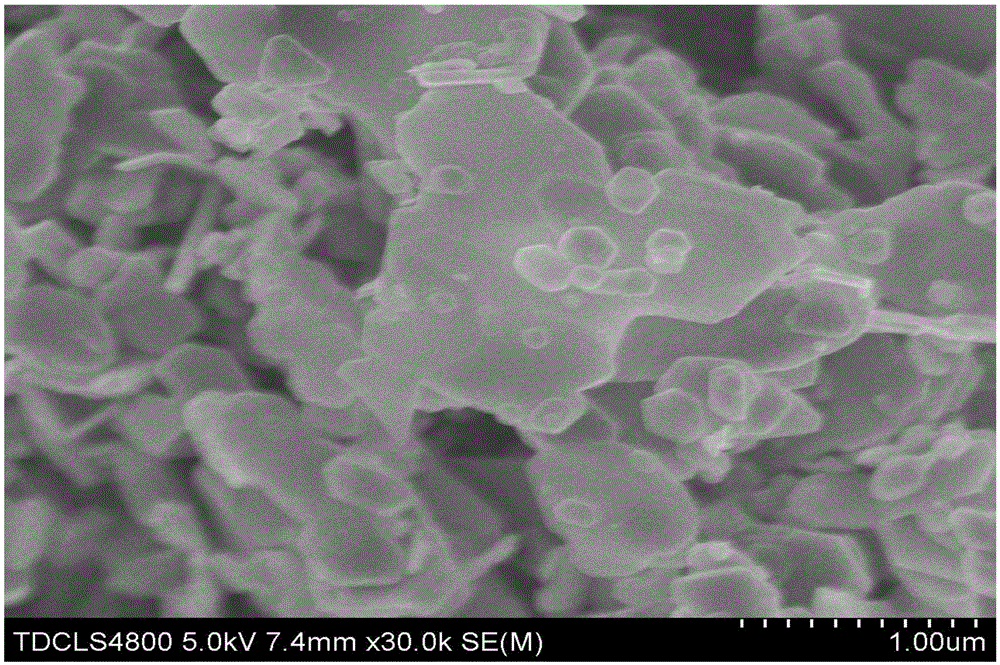Preparation method of non-water-soluble transition metal disulphide nanosheets
A transition metal and disulfide technology, applied in nanotechnology, nanotechnology, nanotechnology for materials and surface science, etc., can solve problems such as uneven thickness distribution of nanosheets, strict process requirements, and sensitive reaction conditions. Achieve the effect of excellent shape, low preparation cost and controllable number of layers
- Summary
- Abstract
- Description
- Claims
- Application Information
AI Technical Summary
Problems solved by technology
Method used
Image
Examples
Embodiment 1
[0029] Weigh 0.3531g ammonium molybdate, 0.3654g thiourea and 17.55g sodium chloride, dissolve the mixture in 100ml of deionized water, stir and dissolve to form a solution with a magnetic stirrer with a stirring speed of 300r / min, and then Sonicate with a 400W sonicator for 15 minutes and mix well. Put the mixture in the refrigerator for 12 hours to freeze, and then place it in a freeze dryer at -50°C for vacuum drying until the mixture is dried. Grind the mixture and pass through a 150-mesh sieve, take 10g of powder and place it in the ark, put the ark in a tube furnace, pass through the Ar inert gas of 200ml / min to remove the air, then use the Ar inert gas of 200ml / min, and use 10 The heating rate of ℃ / min is raised to 750 ℃, and the temperature is kept for 2 hours for chemical vapor deposition. After the reaction is completed, it is cooled to room temperature under the protection of Ar atmosphere to obtain the calcined product A, which is collected, ground and washed with ...
Embodiment 2
[0032]Take by weighing 0.3531g ammonium molybdate, 0.3654g thiourea and 35.1g sodium chloride, dissolve the mixture in 150ml of deionized water, stir and dissolve to form a solution with a magnetic stirrer with a stirring speed of 300r / min, and then Sonicate with a 400W sonicator for 15 minutes and mix well. Put the mixture in the refrigerator for 12 hours to freeze, and then place it in a freeze dryer at -50°C for vacuum drying until the mixture is dried. Grind the mixture and pass through a 100-mesh sieve, take 10g of powder and place it in the ark, put the ark into the tube furnace, pass through the Ar inert gas of 200ml / min to remove the air, then use the Ar inert gas of 200ml / min, and use 10 The heating rate of ℃ / min is raised to 600 ℃, and the temperature is kept for 3 hours for chemical vapor deposition. After the reaction is completed, it is cooled to room temperature under the protection of Ar atmosphere to obtain the calcined product A, which is collected, ground and...
Embodiment 3
[0034] Weigh 0.2463g ammonium metatungstate, 0.1827g thiourea and 23.4g sodium chloride, dissolve the mixture in 100ml of deionized water, stir and dissolve with a magnetic stirrer at a stirring speed of 300r / min to form a solution, and then Ultrasound with a power of 400W for 15 minutes, and mix well. Put the mixture in the refrigerator for 12 hours to freeze, and then place it in a freeze dryer for vacuum drying at -40°C until the mixture is dried. Grind the mixture and pass through a 150-mesh sieve, take 10g of powder and place it in the ark, put the ark in a tube furnace, pass through the Ar inert gas of 200ml / min to remove the air, then use the Ar inert gas of 200ml / min, and use 10 The heating rate of ℃ / min is raised to 750 ℃, and the temperature is kept for 2 hours for chemical vapor deposition. After the reaction is completed, it is cooled to room temperature under the protection of Ar atmosphere to obtain the calcined product B, which is collected, ground and washed wi...
PUM
 Login to View More
Login to View More Abstract
Description
Claims
Application Information
 Login to View More
Login to View More - R&D
- Intellectual Property
- Life Sciences
- Materials
- Tech Scout
- Unparalleled Data Quality
- Higher Quality Content
- 60% Fewer Hallucinations
Browse by: Latest US Patents, China's latest patents, Technical Efficacy Thesaurus, Application Domain, Technology Topic, Popular Technical Reports.
© 2025 PatSnap. All rights reserved.Legal|Privacy policy|Modern Slavery Act Transparency Statement|Sitemap|About US| Contact US: help@patsnap.com



